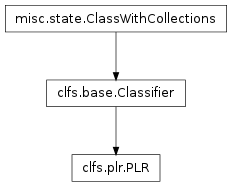This content refers to the previous stable release of PyMVPA.
Please visit
www.pymvpa.org for the most
recent version of PyMVPA and its documentation.
clfs.plr
Module: clfs.plr
Inheritance diagram for mvpa.clfs.plr:

Penalized logistic regression classifier.
-
class mvpa.clfs.plr.PLR(lm=1, criterion=1, reduced=0.0, maxiter=20, **kwargs)
Bases: mvpa.clfs.base.Classifier
Penalized logistic regression Classifier.
Note
Available state variables:
- feature_ids: Feature IDS which were used for the actual training.
- predicting_time+: Time (in seconds) which took classifier to predict
- predictions+: Most recent set of predictions
- trained_dataset: The dataset it has been trained on
- trained_labels+: Set of unique labels it has been trained on
- trained_nsamples+: Number of samples it has been trained on
- training_confusion: Confusion matrix of learning performance
- training_time+: Time (in seconds) which took classifier to train
- values+: Internal classifier values the most recent predictions are based on
(States enabled by default are listed with +)
See also
Please refer to the documentation of the base class for more information:
Classifier
Initialize a penalized logistic regression analysis
| Parameters: |
- lm (int) – the penalty term lambda.
- criterion (int) – the criterion applied to judge convergence.
- reduced (float) – if not 0, the rank of the data is reduced before
performing the calculations. In that case, reduce is taken
as the fraction of the first singular value, at which a
dimension is not considered significant anymore. A
reasonable criterion is reduced=0.01
- maxiter (int) – maximum number of iterations. If no convergence occurs
after this number of iterations, an exception is raised.
- enable_states (None or list of basestring) – Names of the state variables which should be enabled additionally
to default ones
- disable_states (None or list of basestring) – Names of the state variables which should be disabled
|
|---|

